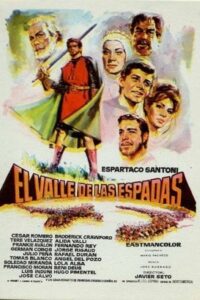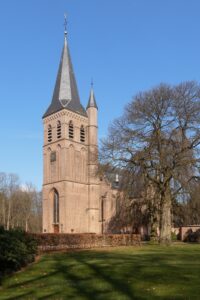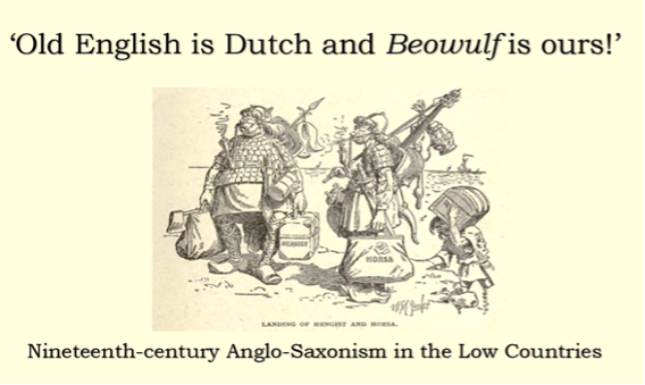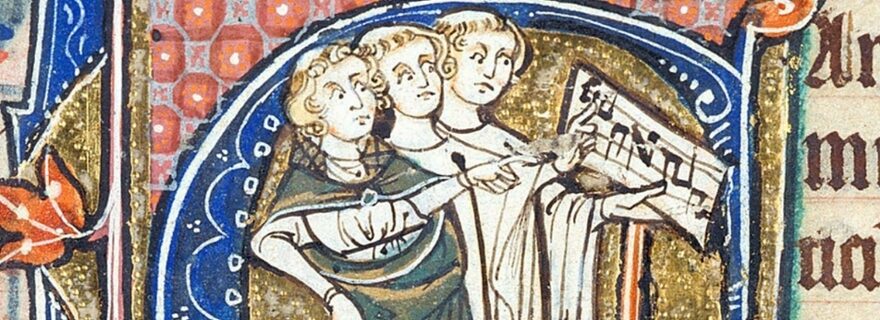Looking Back at “Practices in Comparative Medievalism”
On September 23, 2022, researchers and guests at the Leiden University Centre for the Arts in Society (LUCAS) organised a one-day conference on “Practices in Comparative Medievalism”. Here is everything you need to know about it.
Already in the 1970s, scholars and humanists asked themselves how the idea of the European Middle Ages was interpreted in the Victorian period. This question is key to understanding ‘medievalism’: the reception, interpretation, and recreation of the European Middle Ages in post-medieval cultures. On September 23rd, 2022, researchers of the Leiden University Centre for the Arts in Society (LUCAS) organised a one-day conference, "Practices in Comparative Medievalism", inviting all types of students, researchers, and enthusiasts to share their investigations and contributions concerning cultural representations of the Middle Ages from the Early Modern period until the present.
This one-day conference emerged as the result of a Leiden University Humanities Research Traineeship project supervised by Dr. Daný van Dam and PhD-candidate Fernanda Korovsky Moura, with students Eli Elshani and myself, Alicia Rojas Costa, as trainees. This research project, Arthurian Revival Across the Ages analysed depictions of King Arthur in literature, film, photography and performance art from the nineteenth to the twenty-first centuries. The conference began with a brief introduction to medievalism, where the organisers considered the complexities of the field, its interdisciplinary nature, and the challenge of rewriting history from contemporary narratives. They concluded by stating that we are not dealing with just one form of medievalism, but instead a smorgasbord of medievalisms.


Medieval Identities in the Global World
The first panel, titled Medieval Identities in the Global World, hosted my own paper, along with that of Guus van der Peet (Leiden University). Both papers explored the use of medieval motifs in far right-wing contemporary contexts. In my own case, I decided to present the reception of the figure of St James the Apostle and the role of this reception in the construction of Spanish national identity. Back in the twelfth century, written sources would mention the appearance of St James in multiple battles and conflicts to justify the Christian character of several kingdoms that populated the Iberian Peninsula at this moment in time. This same narrative was recovered and reused in the twentieth century by the dictator Francisco Franco and his regime, subsidizing a new emergent cinematographic genre called Spanish Jacobean Cinema. In my paper, I explored the presence of St James in the film “The Castilian” [El Valle de las Espadas] as a non-explicit form of propaganda for the regime and as a tool used by Franco to reimagine himself as a medieval saviour and knight.
Guus van der Peet’s paper analysed, on the other hand, the unique interpretation of history by Dutch far-right groups. Through a series of case-studies, such as the far-right student group Schild & Vrienden or the alt-right party Forum voor Democratie, Van der Peet demonstrated that when analysing the phenomenon of medieval appropriation, the Dutch-speaking area notably differs from the type of appropriations we see in, for instance, the American and English humanities. In this case, this series of Dutch groups decided to glorify the sixteenth and seventeenth centuries, instead of the Middle Ages. The reasons? Van der Peet pointed out, among others, the comparative lack of heroic references in the Dutch Middle Ages and in the mid-sixteenth century conflict between Catholics and Protestants in the Netherlands. After finishing this first panel, we both concluded that the political usage of medieval motifs always responds to the need of feeling represented by supposedly glorious and contrived past.
Constructing Medievalism through Literature and Religion
We continued throughout the day to search for more forms of medievalism. Our second panel, Constructing Medievalism through Literature and Religion
featured the speakers Birgitte Beemerkamp (independent researcher) and Annelies Abelmann (University of Groningen). Beemerkamp presented research that approached medievalism through perceptions of time and temporality, using Edmund Spenser’s “The Ruines of Time” as its main support. She stated how the “ruined architectural victims” of the Dissolution of the Monasteries under King Henry VIII between 1536 and 1539 served as an important influence for medievalism in sixteenth-century English literature. Through a visual and analytical comparison, Beemerkamp revealed that the core argument in Spenser’s “Ruines” is also encountered in Old English elegiac poetry, such as “The Ruin” and “The Wanderer” in the tenth-century Exeter Book. Moreover, concepts of transience and a nostalgic musing of times past were again reflected on these oeuvres.


Continuing with this second panel, Annelies Abelmann presented her current PhD research, concerning the creation of ‘medieval’ religious spaces in the nineteenth-century Netherlands. Abelmann’s case-study was the Willibrordus Church in Vierakker, built in the year 1869. As she shared during her paper, this building stands as a great example of the effectiveness of the recreation of different medieval concepts in the Dutch context of the late nineteenth-century political Catholic revival. This religious building emerged as a complex space comprising a series of environments such as a churchyard, parish house, primary school, and the community structure. Through the analysis of a series of objects from this space, Abelmann showed how medieval motifs were reused in the Netherlands in the nineteenth century.
Future Reminiscences: Medieval appropriations in Contemporary Culture
The last panel of this one-day conference comprised three papers that returned to contemporary culture in order to bring us new perspectives on modern medievalisms. This panel, entitled Future Reminiscences: Medieval appropriations in Contemporary Culture, started with Lotte Kokkedee’s (University of Amsterdam) paper. She shed a light on Pier Paolo Pasolini’s Il Decameron
(1971) and his unique return to the Italian Middle Ages through a Marxist and anti-capitalist ideology. Kokkedee presented a great case of a revolutionary and visionary filmmaker who perceived the Middle Ages as the time when “man was closer to nature”. As she described, Pasolini found inspiration in Giotto and used the Middle Ages as a basis for his form of social criticism, setting the film in Naples, and focusing on tales about the lower social classes.



Martina Marzullo (Heidelberg University) started her presentation by posing a question to the audience: can the Old English epic poem Beowulf survive in a rural and contemporary American context? She presented two different case-studies which explored different contemporary reinterpretations of the epic poem: Jeff McComsey and Tommy Lee Edward’s Grendel, Kentucky, and Donald Mace William’s Wolfe. Marzullo analysed the core elements of the epic poem along with new features which allow the heroic Beowulf and his epic quests to live into the twenty-first century. She raised issues such as normative forms of masculinity and femininity or the perception of outsider communities and cultures during her discussion. The reconsideration of a “universal” past in specific contexts reminded us of the current problematics faced when trying to rewrite a tenth-century poem in a contemporary key.
The last paper of the conference was presented by Martine Mussies (Maastricht University). Mussies explored the figure of King Alfred of Wessex and the new emergent online narratives surrounding his character that can be found in the realms of online fanfiction. By firstly approaching and explaining what fanfiction is, Martine immersed the audience in the practice of recovering archaeological objects which is currently used by writers of fanfiction to add new layers of knowledge to the story of King Alfred. Describing these objects in depth allows fanfiction writers to blur the lines of demarcation between archaeological facts, historical fiction, and historical fantasy. Many of the objects used in these online narratives can be seen in popular media and series such as Vikings, The Last Kingdom or Assassin’s Creed Valhalla.
Keynote and final reflections
The conclusion of this “Practices in Comparative Medievalism” conference was offered by Dr. Thijs Porck, who carried out a final keynote. The keynote began with a number of reflections on the conference and the field of medievalism studies. First, Porck described how ‘popular medievalism’ is often used as a ‘gateway drug’ to get students interested in the ‘serious’ study of the Middle Ages, but he pointed out that medievalism is worthy of study in its own right (as demonstrated by this conference). Moreover, the distinction between ‘medieval studies’ and ‘medievalism’ is not as clear-cut as it may seem: scholars are not immune to the influences of contemporary ideologies and they create as much of a modern, constructed adaptation of the Middle Ages as do film makers and comic book writers. Porck further highlighted the need for a broader approach to medievalism, one that does not solely focus on Anglophone sources and is open to motivations other than nationalism and far-right extremism.


He next presented his case study on the nineteenth-century reception of the Old English poem Beowulf in the Low Countries, entitled “Old English is Dutch and Beowulf Is Ours! Nineteenth-century Anglo-Saxonism in the Low Countries”. While nineteenth-century Anglo-Saxonism is often associated with English patriotism and American racism, Porck demonstrated that the Low Countries had their own particular type of nineteenth-century Anglo-Saxonism: on wobbly linguistic grounds, scholars and writers claimed that Old English in general and Beowulf in particular belonged to the Dutch literary canon. On the basis of a number of examples, Porck showed that scholarly and popular Anglo-Saxonism influenced one another and were not isolated worlds. Moreover, he demonstrated that after the 1860s, the Dutch claim on Beowulf was refuted by Dutch scholars, who nevertheless retained a keen interest in Old English. The Dutch case thus demonstrates a development from nationalist cultural appropriation to post-nationalist engagements with early medieval heritage.
Reflection
Throughout this one-day conference, a variety of forms of medievalism were discussed: from the construction of national identities to the usage of the Middle Ages in sacred spaces or the handling of archaeological artifacts by fanfiction writers. The conference offered a comfortable environment for the discussion of new contributions that will undoubtedly stretch the limits of the discipline. The discussions that appeared within each panel certainly remind us, once more, that past and present are uniquely embedded in our contemporary imaginary.
Image sources:
Sint Willibroduskerk, Vierakker
Still from Pier Paolo Pasolini’s “Il Decameron”, 1971
Front cover of 'Grendel, Kentucky', 2021
© Alicia Rojas Costa and Leiden Medievalists Blog, 2022. Unauthorised use and/or duplication of this material without express and written permission from this site’s author and/or owner is strictly prohibited. Excerpts and links may be used, provided that full and clear credit is given to Alicia Rojas Costa and Leiden Medievalists Blog with appropriate and specific direction to the original content.


